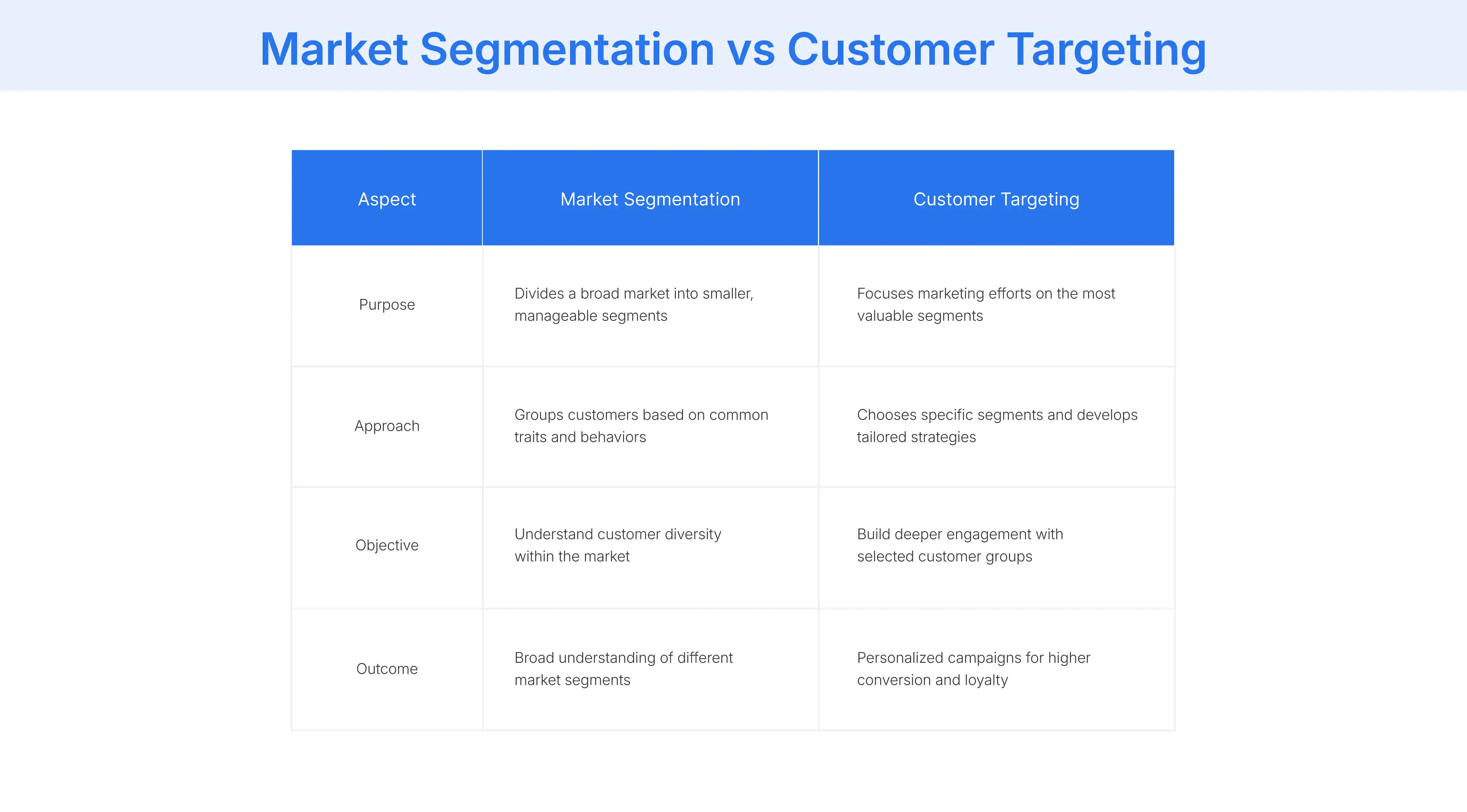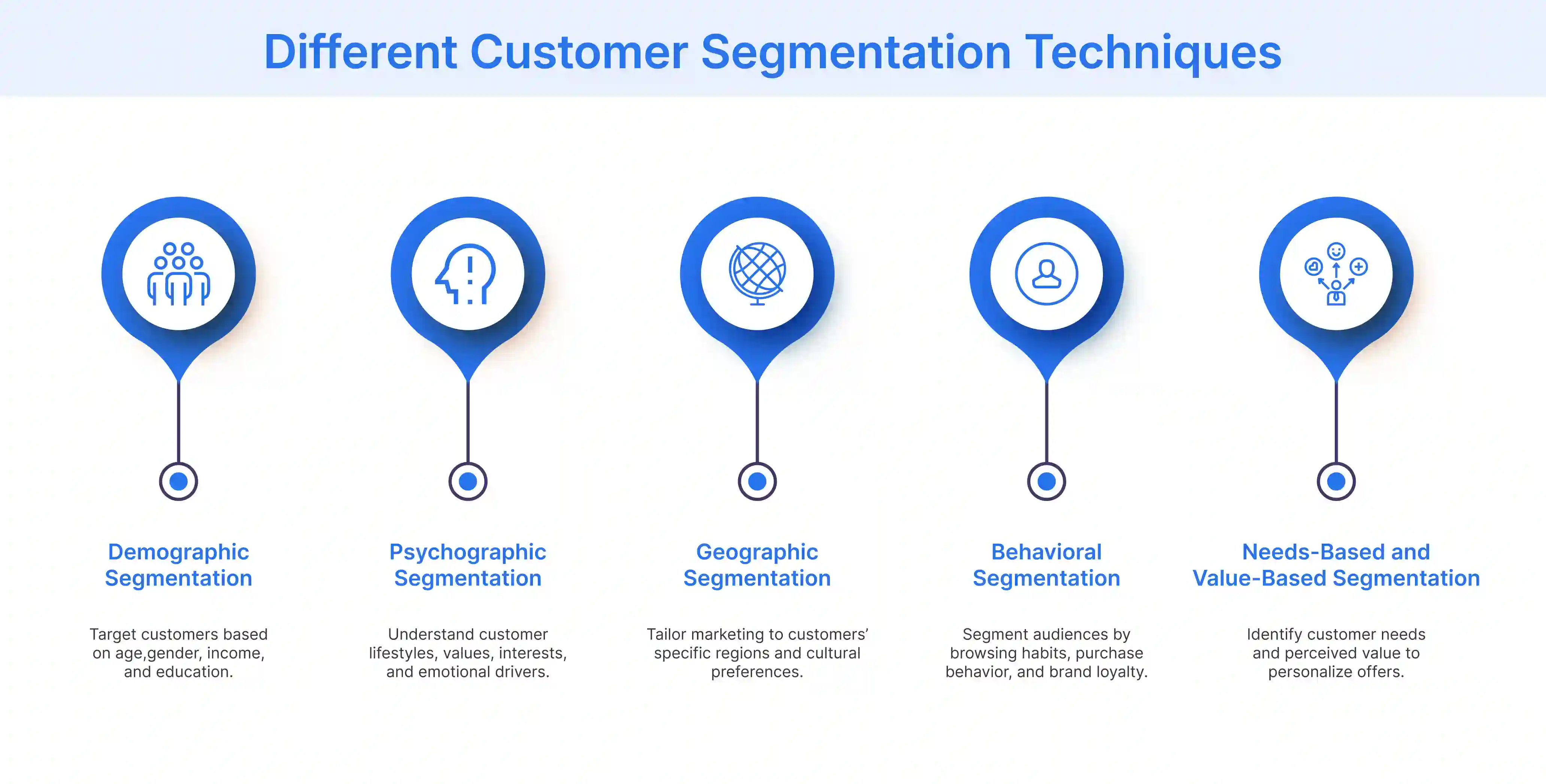Table of Contents
- What is Customer Targeting and How Does it Work?
- Customer Targeting vs Market Segmentation
- What Role Do Targeted Ads and Personalized Marketing Play in Retail Success?
- Which Customer Targeting Techniques Deliver the Best Results?
- What Common Mistakes Should You Avoid in Your Customer Targeting Strategy?
- Conclusion
What is Customer Targeting and How Does it Work?
Customer targeting is an advanced marketing strategy where businesses focus their marketing efforts on specific groups of consumers who are most likely to buy their products or services. By understanding customer characteristics, preferences, and behaviors, companies can deliver more relevant, personalized experiences instead of using a broad, generic marketing strategy.
Customer targeting works by analyzing customer data and segmenting audiences to create focused, effective marketing actions. Here is how it typically functions:
- Identify key customer segments based on demographics, buying patterns, lifestyle, and preferences.
- Analyze customer behaviors to uncover motivations, needs, and pain points.
- Develop detailed customer profiles using data-driven insights and predictive analytics.
- Personalize marketing messages to align with the interests and expectations of each segment.
- Deliver targeted campaigns across the right channels at the most effective times.
- Continuously refine targeting strategies based on real-time feedback and evolving customer behaviors.
Customer Targeting vs Market Segmentation
Customer targeting and market segmentation are closely linked but serve different purposes in your digital marketing mix. Market segmentation involves dividing the broader market into smaller, defined groups based on shared characteristics. Customer targeting takes this a step further by helping you select the most promising segments and tailor a personalized marketing plan for them, driving better results.
Here is a comparative analysis of both strategies along key parameters:

What Role Do Targeted Ads and Personalized Marketing Play in Retail Success?
Modern retailers are moving away from broad marketing tactics and embracing precision-driven strategies that connect with target customers. Targeted advertising and personalized marketing have become essential tools for brands aiming to stand out, build stronger relationships, and drive lasting engagement with their audience.
Let’s explore how these strategies directly impact retail performance:
- Capture customer attention by delivering highly relevant content based on browsing behavior, past purchases, and personal interests.
- Turn generic messaging into personalized experiences that directly address each customer’s specific needs, challenges, and aspirations.
- Improve marketing efficiency by focusing efforts on customer segments most likely to convert and deliver long-term business value.
- Build emotional connections through customized communication that makes new customers feel genuinely seen, understood, and appreciated.
- Strengthen customer loyalty by continuously recognizing individual preferences and responding to evolving needs in a timely manner.
Which Customer Targeting Techniques Deliver the Best Results?
Here are the different customer targeting techniques that retailers can leverage to achieve the desired results:
Demographic Segmentation
Demographic segmentation focuses on categorizing potential customers based on factors like age, gender, income, education, and occupation. Understanding these elements enables businesses to craft social media marketing messages that resonate with distinct audience groups, improving campaign relevance and boosting engagement through more targeted communication.
Psychographic Segmentation
Psychographic segmentation analyzes customers’ lifestyles, values, interests, and attitudes to uncover deeper motivations behind purchasing decisions. This approach allows businesses to position products and design marketing messages and email campaigns that align closely with customer beliefs, aspirations, and emotional drivers, creating stronger brand connections.
Geographic Segmentation
Geographic segmentation involves targeting the customer base based on their physical location, such as country, region, city, or neighborhood. Recognizing regional preferences, cultural nuances, and local buying behaviors enables businesses to tailor offerings and promotional strategies that feel highly relevant to specific geographic markets.
Behavioral Segmentation
Behavioral segmentation categorizes customers based on actions like browsing patterns, purchase frequency, product usage, and brand loyalty. By studying customer behavior, businesses can deliver more personalized experiences, optimize the timing of promotions, and design campaigns that match actual user needs and preferences.
Needs-Based and Value-Based Segmentation
Needs-based and value-based segmentation focuses on understanding what customers truly seek and how they perceive product value. By identifying critical needs and priorities, businesses can tailor offerings, improve messaging relevance, and create stronger value propositions that drive meaningful engagement and long-term loyalty.

What Common Mistakes Should You Avoid in Your Customer Targeting Strategy?
Even the best customer targeting strategies can fail if common mistakes are not carefully avoided. Attention to data accuracy, privacy, and adaptability is essential for long-term success.
- Over-Segmentation: Avoid creating too many narrow customer groups that fragment marketing efforts and dilute the overall strategic approach.
- Outdated Data: Prevent reliance on incomplete information that fails to capture the dynamic nature of customer preferences and market trends.
- Privacy Concerns: Prioritize customer data protection to maintain trust and comply with evolving regulatory requirements and ethical standards.
- Lack of Adaptability: Develop flexible targeting strategies that can quickly adapt to changing market conditions and emerging customer behavior patterns.
- Superficial Insights: Implement comprehensive data analysis techniques that go beyond surface-level understanding to grasp customer motivations and needs truly.
Conclusion
Effective customer targeting has become a crucial pillar of retail success in today’s highly competitive marketplace. By understanding and addressing the specific needs, behaviors, and preferences of distinct customer segments, retailers can create more personalized experiences, increase engagement, and drive sustainable growth.
A well-planned targeting strategy enables businesses to optimize marketing investments, strengthen customer loyalty, and stay ahead in a rapidly evolving consumer landscape.
FAQ
Customer Targeting enhances acquisition by reaching the right prospects and improves retention by delivering personalized experiences that foster deeper loyalty and repeat engagement.
Yes, small retailers can leverage affordable CRM tools, social media insights, and basic segmentation techniques to execute effective Customer Targeting without large investments.
Businesses should review and update their Customer Targeting approach at least quarterly, ensuring alignment with evolving market trends, customer behavior changes, and competitive dynamics.
Retailers must prioritize transparency, obtain clear customer consent, safeguard personal data, and comply with regulations like GDPR to maintain trust while executing Customer Targeting strategies.

